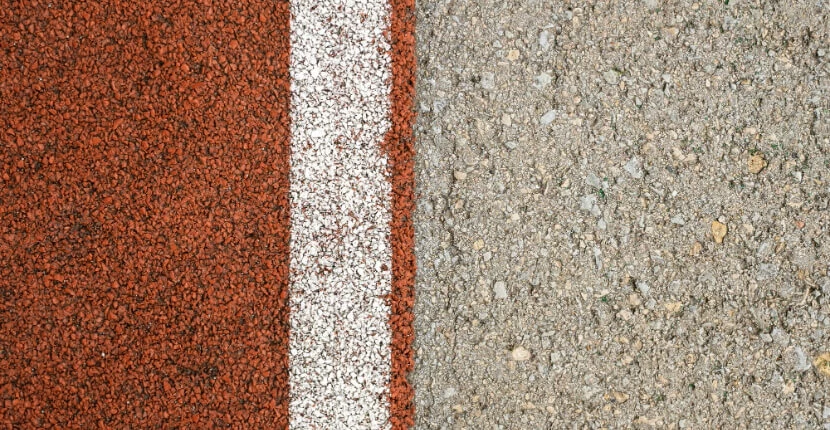
High Friction Surfacing in East Sussex
Contact UsWe install high friction surfacing in East Sussex to improve skid resistance and reduce accidents on roads, junctions and high-risk areas.
Designed for sharp bends, pedestrian crossings, roundabout approaches and steep gradients, it provides superior grip in wet or high-speed conditions.
Our surfacing systems meet UK safety standards and are applied using industry-approved methods.
Clients choose us for fast, reliable installation that enhances road safety and extends surface life.
What is High Friction Surfacing?
High friction surfacing (HFS) is a specialist road treatment designed to increase skid resistance and improve vehicle grip.
High-friction surfacing is typically applied to high-risk areas in East Sussex such as pedestrian crossings, sharp bends, junctions, and approaches to roundabouts or traffic signals.
The system uses a combination of durable resin binders and hard-wearing aggregates, usually calcined bauxite, to create a textured surface that reduces braking distances, especially in wet conditions.
High friction road surfacing meets UK highway standards and is proven to lower accident rates by improving traction where vehicles are more likely to brake or change direction.
HFS is used by councils, highways agencies and private operators to enhance road safety and meet compliance requirements.
Where is High Friction Surfacing Used?
High friction surfacing is used in locations where vehicles are likely to brake, turn sharply or face increased collision risk. These areas demand maximum grip to reduce skidding and improve stopping distances.
Pedestrian crossings in East Sussex: To improve braking performance and protect vulnerable road users
Junctions and roundabouts in East Sussex: Where vehicles slow down, turn or merge into traffic
Approaches to traffic signals: To prevent rear-end collisions when lights change
Sharp bends and steep gradients: To maintain traction and control in high-risk zones
School zones and accident blackspots in East Sussex: To increase safety in areas with high footfall or collision history
Slip roads and motorway exits: Where speed reduction is critical for safe merging or stopping
Bridge decks and elevated surfaces: Where reduced grip from moisture or exposure heightens risk
Local authorities and professional contractors use high friction surfacing in East Sussex to meet safety standards and cut accident rates in these targeted areas.
How much does High Friction Surfacing Cost in East Sussex?
The average costs for high friction surfacing is £40 - £200 per square metre.
The cost of installing a high-friction surface treatment in East Sussex will vary for each project depending on the size of the project and type of material used.
What are the Benefits of High Friction Surfacing?
High friction surfacing in East Sussex improves road safety by increasing grip and reducing skid risk in high-risk areas. It offers measurable safety, durability and compliance benefits.
Reduced Stopping Distances - The textured surface improves tyre grip, especially in wet or fast-braking conditions. This significantly shortens stopping distances, lowering collision risk.
Accident Prevention - It reduces the likelihood of skidding at junctions, crossings, bends and steep approaches. This is particularly effective in accident-prone locations.
Improved Safety for Pedestrians and Cyclists - Better surface grip near crossings and on shared routes protects vulnerable road users and reduces slip hazards.
Compliance with UK Standards - High friction surfacing supports compliance with Department for Transport guidance and Local Authority safety policies. It is often required in road safety audits and improvement schemes.
Long-Term Durability - The use of calcined bauxite and resin binders ensures long-lasting performance under heavy traffic and harsh weather. It remains effective for 5 to 10 years depending on use.
Cost-Effective Risk Reduction - By preventing accidents, it reduces emergency response costs, insurance claims and downtime due to road closures or repairs.
Fast Installation - Quick curing times mean minimal disruption. Most applications allow roads to reopen within hours, reducing impact on traffic flow.
These benefits make high friction surfacing a proven, targeted solution for increasing safety on the UK road network.
How to Install High Friction Surfacing
Installing high friction surfacing in East Sussex involves a controlled process to ensure durability, performance and compliance with UK safety standards. Each stage is critical because poor preparation or application can lead to early failure.
Site Assessment - We inspect the surface for condition, gradient, traffic type and location risk. This confirms suitability for treatment and helps select the correct resin system.
Surface Preparation - The road is cleaned thoroughly to remove dirt, oil, loose debris or existing coatings. A clean, dry surface is essential for proper adhesion.
Masking and Layout - We mask the area to define the treatment zone and protect adjacent surfaces. This ensures a clean, precise finish and prevents overspill.
Primer Application (if required) - A primer may be applied to porous or dry surfaces to improve bonding. This step enhances long-term durability, especially on concrete or aged asphalt.
Resin Application - We apply a specialist resin binder, either hot-applied or cold-applied depending on conditions, using roller or spray methods. The binder forms the adhesive layer for the aggregate.
Aggregate Broadcast - Calcined bauxite is evenly spread over the wet resin to create the high-friction texture. The excess is removed after curing.
Curing and Reopening - The surface is left to cure, typically for 1 to 4 hours depending on the product. Once set, the area is reopened to traffic with full skid resistance in place.
Proper installation in East Sussex ensures the surfacing meets UK Highways Specification Clause 924 and provides lasting skid resistance in critical locations.
How Long does High Friction Surfacing Last?
High friction surfacing typically lasts 5 to 10 years, depending on traffic volume, surface condition and installation quality.
Routine inspections help identify wear early, allowing timely reapplication before safety performance declines.
We cover East Sussex
